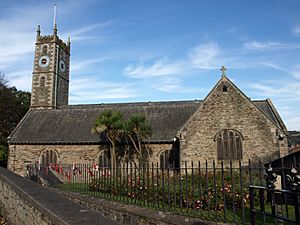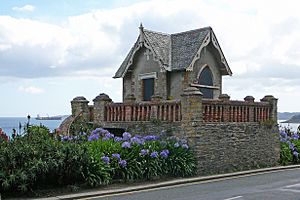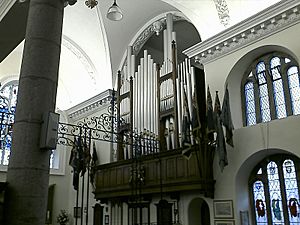Church of King Charles the Martyr, Falmouth facts for kids
Quick facts for kids Falmouth Parish Church of King Charles the Martyr |
|
|---|---|

King Charles Church, Falmouth
|
|
| 50°09′11.02″N 05°04′03.94″W / 50.1530611°N 5.0677611°W | |
| Country | United Kingdom |
| Denomination | Church of England |
| Churchmanship | Broad Church |
| Website | kcm.aspier.co.uk/wordpress |
| History | |
| Dedication | King Charles the Martyr |
| Administration | |
| Parish | Falmouth, Cornwall |
| Archdeaconry | Cornwall |
| Diocese | Truro |
| Province | Canterbury |
The Church of King Charles the Martyr is a special church in the Church of England. You can find it right in the middle of Falmouth, Cornwall, a town in England.
Contents
Discovering the Church's Past
How the Church Began
The building of this church started on 29 August 1662. Sir Peter Killigrew laid the first stones. About 18 months later, on 21 February 1664, the first sermon was preached. This was done by John Bedford, who was a rector from a nearby area.
The church was officially opened on 22 August 1665. John Bedford's son, Francis Bedford, became the first rector. He was chosen by Seth Ward, who was the Bishop of Exeter.
The church was named after King Charles the Martyr. This is a special title for King Charles I. It remembers his execution on 30 January 1649. This happened after the English Civil War.
After the war, King Charles I's son, Charles II, had to leave England. He left from Pendennis Castle, which is close to where the church now stands. He had promised to build a church for public worship if he returned.
When King Charles II became king again, Sir Peter Killigrew helped make this happen. Sir Peter wanted to build a new town and church in Falmouth. He offered land for the church and a home for the priest. He also dedicated the new church to the King's father.
King Charles II and his brother, the Duke of York, helped a lot. Many other important people also gave money. The new area of Falmouth used to be part of another parish. Sir Peter Killigrew made sure the new church had money to run. This came from a small payment from every house in the new area.
However, many people in Falmouth did not belong to the Church of England. They did not want to pay this fee. Later, the church leaders agreed to stop collecting this payment.
Changes Over the Years
The church has been changed many times since it was first built. It was first thought to be about 66 feet square. In 1684, the church was made bigger. Walter Quarme, the third rector, added a special area at the east end. He also built the lowest part of the tower.
In 1686, a balcony was added at the west end. Sir Peter Killigrew paid for this. More balconies were added in 1699 and 1702. In 1702, the first organ was put in. It was built by John Russell from London.
In 1738, the church tower was made taller. It got a large bell, which has since been replaced. By 1813, Falmouth's population had grown a lot. So, the church was made even longer towards the east. The special area at the east end was rebuilt.
The church building started to get old in the early 1800s. In 1896, a big rebuilding project began. The old roofs and balconies were removed. The walls were made higher. New decorated ceilings were put in. This work took about a year.
Later improvements included a new room for the organ in 1915. The old organ area became the Warrior Chapel. Electric lights were added in 1907. In 1936, a special area for baptisms was created. The font, which is used for baptisms, dates back to 1759.
One historian said that this church has probably been changed more than almost any other church in the United Kingdom.
William John Coope's Time
The Reverend William John Coope was the rector from 1838 to 1869. He was important for bringing new ideas to Cornwall's churches. When he was studying at Oxford University, he was influenced by a movement called Tractarianism.
When he came to Falmouth, the church needed a lot of repairs. Coope introduced new ways of doing church services. Some people in the church did not like these changes at first. However, by 1847, most of the opposition had stopped.
Coope wrote many books and papers. These explained that the Church of England was part of a wider Christian tradition. During his time, the church building improved a lot. New rooms for the clergy were added. A new entrance porch was built on the north side. There were also new stained glass windows and a new pulpit.
Some people still disagreed with Coope's practices. This led to a disagreement with a church leader in 1866. But Coope had support from a group called the English Church Union. So, the legal action against him did not go ahead.
Rectors of the Church
- Francis Bedford 1664–76
- John Quarme 1676–79
- Walter Quarme 1679–1728
- John Millington 1728–35
- Edward Walmsley 1735–95
- John Watkin Wilbraham 1795–1824
- Lewis Mathias 1824–28
- Hon. William Wodehouse 1828–38
- William John Coope 1838–70
- Joseph Baley 1870–72
- John Wright 1872–82
- Brian Christopherson 1882–1912
- Henry Hugh King 1912–18
- Montague Blamire Williamson 1918–1924 (later Archdeacon of Bodmin)
- Bertram Liddell Hope 1924–36
- Osmund Ralph Maude Roxby 1936–46
- Joseph Percy Hodges 1946–55
- Thomas Barfett 1955–77 (later Archdeacon of Hereford)
- William John Peter Boyd 1977–85
- Roger Geoffrey Gilbert 1986–2002
- Stephen John Tudgey 2003–Present
Music at the Church
For many years, the church had a choir made up only of men and boys. This choir stopped in the late 1960s because it was hard to find new singers. Now, the choir has adult singers who sing at two services every Sunday.
There is also a series of lunchtime concerts. These happen on Saturdays between May and October. Lance Foy, the Director of Music, started these concerts in 2012.
The Church Organ
The church has a large organ built by Lance Foy from Truro. It is the second largest organ in Cornwall. The biggest is the Father Willis organ at Truro Cathedral.
The first pipe organ was put in the church in the spring of 1703. It was built by John Russell from London and cost £200. Not everyone liked it. One local writer made fun of it, saying it sounded like "old pigs grunting and little pigs squeaking."
After 95 years, the organ was old and needed a lot of work. It was taken apart and sold. A new organ was ordered in 1798 from Hugh Russell, another London builder. This new organ had fifteen stops and a special part that could make the sound louder or softer.
By 1881, the second organ was also in bad shape. It was sold and replaced by a new organ built by Hele and Co. from Plymouth. This organ was placed in the Warrior Chapel. In 1910, some changes were made to the organ's sound. More changes were made in 1914. A new room was built for the organ, and it was moved to its current spot. This work was finished by Christmas 1915. The organ had 30 different sounds and 1,886 pipes. In 1949, the instrument was cleaned. A new blower, which helps the pipes make sound, was installed in the 1950s.
By the 1970s, the organ was very difficult to play. In January 1978, Lance Foy began working on a new instrument. In 1979, a new organ was installed. It used parts from an old church in Bristol and many pipes from the previous Hele organ.
In 1993, Lance Foy rebuilt the organ again. He made many improvements to its sound. He added new pipes and made the control panel better. You can find a detailed list of the current organ's parts online.
Organists of the Church
- William West 1703–29
- Charles West 1729–60
- Edward Kendall 1760–1808
- Anthony Williams 1808–10
- Mathias Cisteraansz 1810–12
- Miss Jane Petherick 1812–15
- Mr. Parnell 1815–24
- Mr. Sharp 1824–30
- George James Webb 1830–42 (later organist of Old South Church)
- Professor Joseph Hale Coggins 1842–62
- Charles William Reed 1864–78
- William Treweeke 1878–80
- Professor C. W. Robinson 1880–95
- Robert E. Clark 1895–1911 (formerly organist of Winkfield Parish Church, Windsor)
- Ewart West 1911–24 (previously organist of Moreton-in-Marsh).
- E. Arthur West 1924–27
- Richard Glendinning 1927
- Gordan Hall 1927–72
- Ernest Green 1972–74
- Edward Goldsmith 1974–91
- Peter Young 1991–2001
- John Charles Winter 2001–07 (formerly organist of Truro Cathedral)
- Christopher Uren 2007–10
- Lance Foy 2010–14
- Richard Bailey 2015–Present
Important Burials



